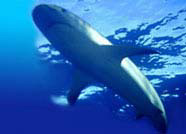


Bull sharks

 |
 |
 |
|||
| Home | Evolution
| Classification
| Glossary | Biology
| Behavior | Shark
Repellent | Shark
Conservation | Do's &
Don'ts | Did You Know?
Bull sharks |
 |
||||
|
Bull/Ganges/Nicaragua/River/Shovelnose/Slipway grey/Square-nose/Van Rooyen's/Zambezi
shark
Scientific name: Carcharhinus leucas Bull sharks are large, robust sharks that hunt in murky coastal waters and rivers, and are commonly implicated in attacks on humans.  They
have grey backs and white bellies, with a short, blunt snout. They are
a chunky species and the dorsal fin is placed relatively far forward on
the shark's back. They
have grey backs and white bellies, with a short, blunt snout. They are
a chunky species and the dorsal fin is placed relatively far forward on
the shark's back.Relatively slow moving fish, these sharks are good predators, feed on variety of prey including other shark fish, rays, turtles, dolphins, carcasses and crustaceans. They are distributed in all tropical and subtropical seas along the coastlines. They are also one of the only sharks to venture into freshwater rivers and lakes, including Lake Nicaragua and the Amazon. They are thought only to be able to live in fresh water for a short time, although they have been recorded 2,500 miles up the Amazon. Bull sharks may possibly be the most frequent attackers of humans. The wounds they inflict are often attributed to great whites, though they are less selective feeders and occur closer inshore and in freshwater. They have attacked bathers in various freshwater and estuarine localities, including regularly in the Hooghli of India, and as far upstream as Baghdad in Iraq. Interestingly, they are more docile when encountered in clear water habitats and are increasingly encountered by divers, without incident. They prefer to hunt in murky waters where they can surprise their prey. Bull sharks are solitary, but will form group while feeding. Females give birth to 1-13 pups after a gestation period of about a year. This specie is not considered endangered. Statistics: The largest bull shark was recorded at 3.4m, but on average, females reach lengths of 2.5m and males 2.3m. Bull Shark Classification:
|
|||||
| Sitemap | Reach To Us | Jimtrade - Business Directory of India | |||||